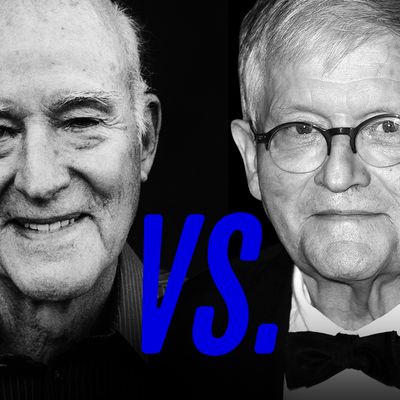
Lawrence Weschler lowers his voice to a whisper whenever he mentions the names David Hockney and Robert Irwin in the same sentence. Weschler, who has written books and essays on both artists, has gotten into trouble for comparing them in the past. Anytime he publishes something about one, he immediately gets a call from the other complaining about whatever was said.
Their dispute isnÔÇÖt personal ÔÇö Hockney and Irwin have never met ÔÇö but they have been waging what may be the greatest meta-catfight in art history. They have been taking swipes at each other, via Weschler, ever since he came out with his much-beloved biographical portrait Seeing Is Forgetting the Name of the Thing One Sees: Over Thirty Years of Conversations With Robert Irwin┬áin 1982.
When Hockney first read the book, he was compelled to call its author to tell him that everything in it was wrong, but that he wanted to discuss it more. That eventually led to WeschlerÔÇÖs True to Life: Twenty-Five Years of Conversations With David Hockney┬áin 2009. (In an afterword to the book, Weschler lets Irwin backhand Hockney: ÔÇ£ÔÇÖyouÔÇÖve got me all wrong, IÔÇÖve always thought him a first-rate practitioner,ÔÇÖÔÇØ he said of the painter.)
Having mediated this feud for decades, Weschler is loath to dredge it up again now, least of all to a reporter. But despite the artistsÔÇÖ vast differences ÔÇö Irwin is a pioneer of the California Light and Space movement; Hockney an English portrait and landscape painter ÔÇö itÔÇÖs surprisingly hard to talk to about one without the other. Their work asks questions that Weschler believes are, at their core, ÔÇ£almost identical.ÔÇØ
We agree to put the debate aside, for now, to tour IrwinÔÇÖs latest show at Pace Gallery. ItÔÇÖs called ÔÇ£CacophonousÔÇØ ÔÇö a title Weschler doesnÔÇÖt like. ÔÇ£I told him he couldÔÇÖve given it a great title, and that title is, ÔÇÿThe Wave Breaks,ÔÇÖÔÇØ he says. Irwin dismissed that out of hand (ÔÇ£too romanticÔÇØ). But Weschler thinks it conveys the bigger picture: the dramatic conclusion of a 20-year cycle. Irwin told him that these are the last sculptural light shafts he will make, and furthermore, the last works he will make to sell.
Plus, the wave is about to come into full view on June 1, when Irwin reinstalls his Excursus: Homage to the Square┬áat Dia: Beacon. This early fluorescent work, originally shown at the foundationÔÇÖs Chelsea space in 1998, is what Weschler describes as the artistÔÇÖs spare ÔÇ£romanesqueÔÇØ period, which, like in medieval architecture, would evolve into increasingly ornate styles.
At Pace, the rows of multicolored fluorescent lights mounted vertically on the walls do not seem so distant from the hardware minimalism of Dan Flavin at first glance. But a closer look slowly begins to reveal a network of lines, textures and symmetries so elaborate it is ÔÇ£almost rococo,ÔÇØ Weschler says. HereÔÇÖs how he describes it:
ÔÇ£There are times when you canÔÇÖt tell what the hell youÔÇÖre looking at. Are you looking at reflection? Are you looking at shadow? Are you looking at double shadow? And then, on top of that, he starts painting the sides of some of the armatures black. Some are painted a kind of light gray, the color of a shadow, some a darker gray. Sometimes thereÔÇÖs a single strip of black coming down the side, sometimes there are these double stripes ÔÇö these Barnett NewmanÔÇôlike ÔÇÿZips.ÔÇÖ Some of the lights are on, some are off ÔǪÔÇØ
This complexity unfolds only with sustained attention, however. IrwinÔÇÖs end goal is the suppression of all external associations ÔÇö to forget the name of the thing one sees ÔÇö so that the only activity left is that of ÔÇ£perceiving yourself perceiving,ÔÇØ as Irwin puts it. ÔÇ£Every time we walk into a show, I always start free-associating, and he says, ÔÇÿShut the fuck up. CanÔÇÖt you ever just shut up?ÔÇÖÔÇØ Weschler says. Eventually, the visual contradictions ÔÇö flatness becomes depth, color becomes the reflection of color ÔÇö begin to scatter oneÔÇÖs mental bearings.
This is where Weschler sees Irwin coming back to Picasso, to the crux of his practice, and ultimately, back to Hockney (who also shows at Pace, and has a concurrent exhibition up at its gallery in Beijing). ÔÇ£When you begin to see multiple perspectives, when you stop being locked into the optical,ÔÇØ Weschler says, ÔÇ£I suspect [Irwin] would take that back to Cubism.ÔÇØ
As trivial as the squabbling may sound, Hockney and IrwinÔÇÖs dispute itself is entirely meaningful. Both artists consider Cubism, the collapsing of figure and ground, the most significant artistic advancement in centuries. They both imagine where Picasso and BraqueÔÇÖs work would have gone if theyÔÇÖd lived longer, and both conclude that it would be precisely where their practices have taken them.
Naturally, thatÔÇÖs where they diverge. Irwin believes that Picasso would have taken the road to abstraction. The painter would have wondered, as Irwin does, ÔÇ£What would it be like to look at the ground with the same intensity you ordinarily reserve for the figure?ÔÇØ Weschler explains.
For Hockney, Picasso was all about the figure. ÔÇ£Hockney would say that figuration is something thatÔÇÖs been going on for 30,000, years and it doesnÔÇÖt just disappear in a generation,ÔÇØ Weschler says. As photography threatened the necessity of painting, Cubism proved that there were subjective realities that photos could never capture.
The artists, now both octogenarians, will probably never agree. But itÔÇÖs ÔÇ£a conversation they could really have,ÔÇØ Weschler says, ÔÇ£and they would enjoy each other.ÔÇ£

